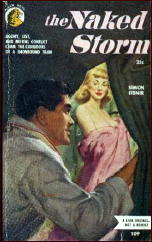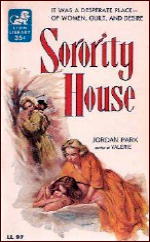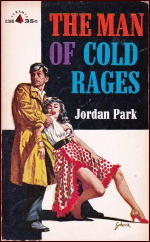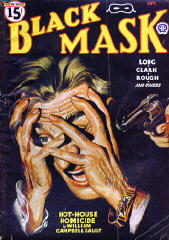Fri 22 Mar 2013
THREE CRIME NOVELS BY C. M. KORNBLUTH, by Josef Hoffmann.
Posted by Steve under Authors , Pulp Fiction , Reviews[14] Comments
by Josef Hoffmann
C. (Cyril) M. Kornbluth (1923–1958) is a well-known science fiction author. What is less well known, however, is that he was also a successful crime writer. In the second half of the 1940s he wrote detective stories for pulp magazines. Later, he published crime novels under the pseudonyms Jordan Park and Simon Eisner. According to Hubin’s bibliography, these were:
— Jordan Park: Sorority House, Lion Library LL97, 1956 (together with Frederik Pohl); cover art: Clark Hulings.
— Jordan Park: The Man of Cold Rages, Pyramid Books G368, 1958; cover art: Harry Schaare.
A further novel, written jointly by Pohl and Kornbluth, can be found in Hubin: Gladiator-at-Law (Ballantine, 1955). In addition, there were Kornbluth’s novels Takeoff (Doubleday, 1952) and The Syndic (Doubleday, 1953). These novels have elements of a criminal plot, but because the action is set in the future and these novels are generally considered to be science fiction, I omit them here.
Kornbluth’s earliest crime stories include the two detective stories in Black Mask: “Beer-Bottle Polka†(September 1946; Vol 29 #1; pp 35-43) and “The Brooklyn Eyeâ€, 29, No. 2 (Nov 1946; Vol 29 #2; pp 79-94). The hero and narrator in each case is Tim Skeat, a private detective in New York City. Some action elements from earlier Pulp stories are reused in the crime novels.

The Naked Storm tells of a train journey through a snowstorm from Chicago to San Francisco. The locomotive eventually gets stuck in the snow on a pass in the Rocky Mountains, and the people on the train are cut off from civilization for three days. Using numerous observations and experiences, the novel describes how individual persons prepare for the train journey while the snowstorm is approaching, as well as the journey itself and the catastrophe.
The novel has no underlying continuous narrative thread, but is instead constructed from larger and smaller illustrations of impressions and actions on the part of the persons involved. The combined narrative particles generate an overall impression that constantly changes, like the pictures in a kaleidoscope. While the reader is at first somewhat clueless, due to the diversity of the impressions and experiences, events intensify during the train journey around four persons:
— Mona Greer, a lesbian bestselling author, who uses her glamorous status to seduce inexperienced young women, who she then proceeds to discard, once she has enjoyed her sexual conquest.
— Joan Lundberg, a pretty young woman, who is traveling to a political conference in San Francisco.
— Boyce, a businessman in the floor coverings industry, who is unhappily married.
Both Boyce and Greer have their eye on Joan Lundberg. Foreman supports Boyce, as he hates lesbians like Mona Greer.
The novel describes how environmental conditions influence people’s behavior, in particular how they compulsively abandon their moral standards in the face of snow and freezing ice. The bar is plundered, drugs are stolen from the doctor’s bag, insults and fistfights abound. And Foreman decides to murder Greer.
The novel is more of a mainstream novel than a crime novel. Some of Kornbluth’s own experiences are worked into the depiction of Hal Foreman. This makes it all the more dubious that the reader is expected, through the manner in which the novel is written and concludes, to identify with Foreman’s prejudice against and hatred of homosexuality. This diminishes the quality of the novel considerably.

Sorority House is to an even greater extent more of a mainstream novel than a crime novel. Life in the Eleusis Academy for Women, a college in a small provincial town in Pennsylvania, is presented in a socially critical manner. The head of the college is Dr. Mildred Matthewson, an old maid and historian, who tyrannizes and spies on both students and teaching staff. She is malicious, extortionate and scheming.
Four female students and three teachers form the centre of events. The four young women are accepted into to the sorority of the Lambs and enjoy the privilege of living in their house. They are Ann Riker, an aspiring writer, who is keen to suppress her lesbian inclinations, Kathryn Jackson, a stipendiary from the lower classes, who wishes to become a Latin teacher, Joy Squires, a beauty who embarks on a relationship with a young lecturer, and Clara Gwynn, a rather chubby student who develops a talent for mathematics. The three lecturers are the young English teacher Jim Henschel, the journalism teacher James McGivern, a drinker, and the new, unapproachable mathematics teacher Dr. Crouch.
The entanglements that befall the students and lecturers are told in an exciting manner. But the action only takes a turn towards becoming a crime novel from page 166. During a dance party, arranged elaborately by the Lambs, Dr. Matthewson is found dead in the night, away from events, in the Mall. The police investigation, which commences immediately, establishes that the death was violent: it is murder. As the head of the college was not short of enemies, there are numerous suspects. Some detection and dramatic action takes place on the last 25 pages. The solution is no surprise.
From our current perspective the prejudices against lesbian love and against women who aspire to social mobility by means of an academic education are reactionary. These prejudices become apparent above all at the end of the novel, which is not revealed. There is also an alarming empathy for a kind of self-justice. Finally, the different blurbs on both Lion Books falsify the content of the narrative by means of exaggeration, which I find annoying, and which does not do justice to the authors.

The hero of the third novel, The Man of Cold Rages, is Leslie Greene. His wife Peg and son Val are run over and killed by a car in Chicago. The car is driven by contract killers who shot Dr. Emilio Hernandez, who was sitting on a bench, and then killed the two likely witnesses to the crime, Peg and Val, with their car. Hernandez had been granted political exile. He came from the (fictional) Republic of La Paz, a small South American country ruled by the fascist dictator General Serrano. Hernandez was obviously murdered because of his oppositional political activities.
Life no longer has any meaning for Leslie Greene. The only thing that still interests him is the punishment of the murderers. However, the police investigation is unsuccessful. Greene decides to travel to La Paz in order to kill the person who ordered the murders, General Serrano. For an indeterminate period he moves into a hotel in the republic’s capital city, which is decorated by countless portraits and statues of the dictator.
Because Greene is an artist who can paint excellent portraits, he tries to attract attention by painting the portrait of the hotelier’s cousin, Senorita Isabel Rocas. He achieves this quite quickly, leading to the intended invitation to see General Serrano. It is arranged that he will paint a portrait of the dictator, who will model for the painting regularly.
At the same time, Greene makes contact with the opposition, which operates underground. The opposition is planning a non-violent upheaval and a general strike. Greene’s plan to murder the dictator is rejected by the members of the opposition. But Greene sticks to his decision. Events take their course and are complicated further by the fact that Isabel falls in love with Greene.
The Man of Cold Rages is a mixture of political thriller and suspense novel and resembles at times the novels of Eric Ambler. The typical Ambler protagonist lands in terrible danger and political adventure, without knowing what is happening to him; in contrast, Kornbluth’s hero seeks out the challenge cold-bloodedly.

This novel is not for readers who prefer their books to be as realistic as possible. For example, it is very unlikely that a visitor to a severely guarded dictatorship can transport a loaded pistol in his luggage on an airplane without any prior precautions, so that the weapon is only discovered by an overly enthusiastic chambermaid in the hotel. Otherwise the thriller is well written, with a number of very impressive scenes. It is exciting to read, albeit not without a certain amount of clichés.
While Kornbluth’s first Black Mask story is roughly hewn and bursting with violence and cruelty, he refined his narrative technique in the crime novels, using violent scenes in a more differentiated manner. Kornbluth sometimes found himself to be cruel. This was contradicted by acquaintances, who considered his behavior to be friendly.
The truth is that he was cruel in his fantasy world, as demonstrated in his first Black Mask story and – in diluted form – still in his first thriller. However, his literary attitude towards violence and self-justice obviously changed over the years, as can be seen in his final crime novel.
It is a pity that the author died so young; we have been deprived of some probably very entertaining thrillers as a result. To those who wish to learn more about Kornbluth I recommend the detailed biography by Mark Rich: C. M. Kornbluth: The Life and Works of a Science Fiction Visionary.
March 22nd, 2013 at 10:57 pm
I read his 3 mainstream/crime novels many years ago and while I found them of interest, I’ve always considered his SF work to be of higher quality. I did enjoy his two hardboiled short stories in BLACK MASK however.
I wish someone would reprint the 3 novels that are discussed above; they would make a nice volume.
March 22nd, 2013 at 11:01 pm
I may have read THE SYNDIC back when I first joined the Science Fiction Book Club — can it really be 60 years ago?
I know I bought the book as one of the monthly selections — and I still have it.
But if I ever read it, it’s the only one of Kornbluth’s novels I’ve read. But — and this is a big but — I’ve read lots of his short fiction, starting when I was 12 or 15 — and he’s been one of my favorite SF writers ever since. Wonderful stories, all of them, even his earliest, earliest ones.
March 22nd, 2013 at 11:14 pm
If you want a taste of just how cruel Kornbluth could be, check out his story “Shark Ship”.
March 23rd, 2013 at 1:05 am
“Cruel” maybe, but also visionary and maybe an ultra form of tough-minded realism. Most of Kornbluth’s short fiction can be found in His Share of Glory: the Complete Short Science Fiction of C.M. Kornbluth, edited by Timothy P. Szczesuil (NESFA Press, 1997). 670 pages, 56 stories. Worth whatever price you have to pay for it.
March 23rd, 2013 at 1:13 am
Steve mentions Kornbluth’s short stories. They are excellent and just about all are reprinted in HIS SHARE OF GLORY, 56 SF stories. One of my favorites is “TWO DOOMS” which deals with a world where Japan and Germany won the war.
I joined the SF Book Club back in 1956 and I still have Kornbluth’s novels: THE SYNDIC, TAKEOFF, and NOT THIS AUGUST. I also liked THE SPACE MERCHANTS and GLADIATOR AT LAW which he wrote with Fred Pohl. I have GUNNER CADE and the other one he wrote with Judith Merrill (MARS CHILD?) but didn’t enjoy them as much.
An excellent author and his death at 34 while shoveling snow cut short a brilliant career.
March 23rd, 2013 at 8:46 am
C. M. Kornbluth’s Black Mask story “BEER-BOTTLE POLKA” is reprinted in The Black Lizard Big Book of Black Mask stories, edited by Otto Penzler. In this book M. is the initial of Michael. But in Rich’s biography M. stands for the initial of the name of Kornbluth’s wife Mary.
By the way, a book with all of his crime stories in various pulp magazines would be an interesting short story collection.
March 23rd, 2013 at 1:17 pm
I read The Man of Cold Rages about 20 years ago, after Spider Robinson made a passing recommendation of it in a book review column. I remember being impressed with its political sophistication; Kornbluth’s use of Gandhi’s nonviolence tactics, several years before they reached prominence in the American civil rights movement. It’s also an interesting character study. I highly recommend it.
It’s my understanding, from comments made by Fred Pohl and others, that Kornbluth had no middle name. Apparently he didn’t like his first name enough to use it in a byline so he manufactured the “M” so he would have two initials to use. It’s my understanding that J. K. Rowling’s middle initial is equally fictitious.
March 26th, 2013 at 7:09 am
Frederik Pohl also finds the Rich biography repugnant, as it is remarkably hostile to Pohl (apparently to a highly distorting degree). For more on Kornbluth by those who actually knew him, one could turn to Damon Knight’s THE FUTURIANS (another book Pohl is not fond of, but mostly for being indiscreet rather than dishonest), Judith Merril’s BETTER TO HAVE LOVED, and Pohl’s own THE WAY THE FUTURE WAS. Among other memoirs.
March 29th, 2013 at 11:40 am
Why no mention of Half, also by “Jordan Park”, the story of a male sex-change? Another interesting and offbeat Kornbluth non-sf title.
March 29th, 2013 at 11:54 am
Not only interesting and offbeat, Greg, from your description, but another example where Kornbluth was well ahead of his time.
No mention by Josef, I presume because of its lack of crime content, but thanks for bringing it up!
March 29th, 2013 at 12:45 pm
I’ve always suspected “Shark Ships” inspired Paul Kantner to write “Wooden Ships.” I met Pohl once; great guy.
March 29th, 2013 at 4:08 pm
I have only mentioned crime novels which are listed in Hubin’s bibliography. There is another novel by Jordan Park: VALERIE, Lion Book 176. It is a historical novel about witch-hunting.
By the way, I paid more than just some dollars for each paperback I reviewed. The most expensive book was SORORITY HOUSE.
March 30th, 2013 at 10:40 am
I’m with Walker: I wish STARK HOUSE or some other small press would reprint these Kornbluth novels. And Steve is right: His Share of Glory: the Complete Short Science Fiction of C.M. Kornbluth is worth having in your collection
January 27th, 2015 at 2:45 am
Thanks for this info about Cyril’s hard-to-find non-SF. I worship CMK. He was the Shakespeare of the 20th century, and very prescient. PLEASE PLEASE, someone reprint his non-science fiction. I have read Pres. Year (so true) and A Town Is Drowning (so poignant) by inter-library loan, but the offbeat titles above are unavailable even that way. Cyril had quite the far-flung interests, very bizarre too. As he put it in a short bio at the end of one of his collections, “…everything except sports.” Even that I have come to agree with him about.